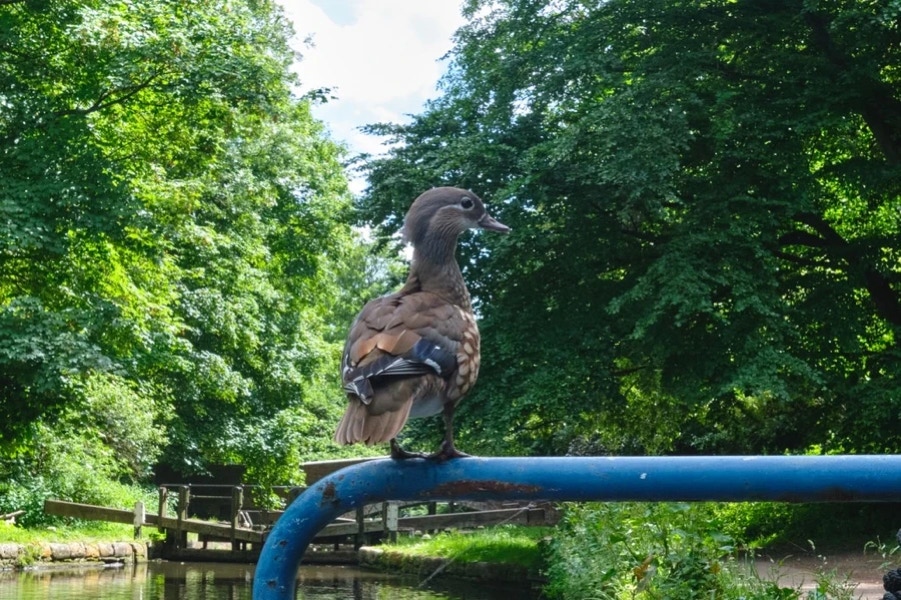16/6/2022

Bird On A Tiller
This week I have been celebrating the arrival, while I was still in Rickmansworth, of my brand-spanking-new leisure batteries: four 12 volt Rolls 128ah AGMs, for those who understand these things. For those who do not understand these things and, such as myself, refer to batteries as magic boxes, all you need to to know is that these particular units hold more power than you can shake a stick at and they’re sealed – the latter point meaning that I won’t have to crawl into the engine bay every few months to top them top with deionised water. On the packaging they’re even described as ‘no maintenance’ – which, I’m sure you’ll agree, is the best kind. Hey-nonny-nonny and hip-hip-hurrah! Each one weighs 70.5 lbs, which means they arrived on a pallet which the driver, thankfully, put on a trolley and delivered to the boat. While I was waiting he had the courtesy of calling to say he was about twenty minutes away in King’s Langley. King’s Langley, I thought. One of my favourites destinations. Perhaps I’ll stop there next.
With that in mind, the following day with my new batteries on board but not yet installed, I set off. Four hours and five locks later I arrived in Cassiobury – about half way, as the boater navigates, from my starting point. Rickmansworth to King’s Langley: roughly, twenty minutes by road, but eight hours by boat. Nowhere is the old adage, “it’s about he journey and not the destination”, more true than when travelling the canals.
I was more than happy to pit-stop in Cassiobury, which is another regular mooring for me. Even though it’s only a half-hour walk to the centre of Watford it’s one of the first stops, moving away from London, that begins to feel properly rural. The local wildlife is both plentiful and, as you can see from this entry’s top photograph, friendly. There’s also a wildlife sanctuary (www.cassioburyfarm.com), with some not-so local residents, which holds a few open days every summer. I had the pleasure of attending one of them last year and was amazed at the diversity of the menagerie – including donkeys, rare breed pigs, lamas, kangaroos, zebras, meerkats, ring-tailed lemurs, porcupines, a kookaburra and even an arctic fox. (Although it must be said the kookaburra is rude, ornery and best avoided). According to the sign on the gate their next open days are 24th July, 7th August, 27th August and 28th August. Should you be in the area, or even prepared to make a special trip, I highly recommend it as a fantastic day out.
Always open and free to visit, Cassiobury Park is a popular summer spot for families, dog walkers and cricketeers, with a superb cafe at it’s centre. But it’s real highlight, standing majestically on the side of the hill, is the Cedar Tree Of Lebanon which, after many years of visiting, I now consider an old friend.

Cedar Tree Of Lebanon
Having visited one of my favourite trees, changed over my batteries (which, happily, wasn’t nearly as arduous a task as I’d anticipated) yesterday I set off for the second leg of my intended trip. Eight locks in total and only a couple of miles, the journey should have taken about four hours, but instead took closer to five and a half. This was mainly due to the disgrace that is the pound between Cassiobury Locks which, due to years of poor investment, has become close to being unnavigable – at least for a solo boater. I have no idea when that stretch was last dredged but I’m guessing it was either many years ago or, if more recently, the job was poorly executed. Apparently, in order to save money, the Canal And River Trust have taken to only dredging the very centre of the canals since, according to their grey-suited logic, a boat only moves through the middle bit. This entirely fails to take into account the rather obvious facts that boats to have to move aside to get around oncoming traffic and, just occasionally, they also moor up. In this particular pound even the lock landings, where a boat must moor so we can come ashore to operate the locks, are so heavily silted that, even when the water level was reasonable, I found myself having to over-rev the engine to power through the viscous and pebble filled muck. Having struggled though the first of the two locks I was horrified to find that, because the gates are leaking so badly, the water level had dropped to such an extent that the boat was beached. After an hour of running back and forth trying various combinations I found that the only way I could re-float her was to open the bottom gate and the top paddle of the top lock to fill the pound, and then keep the top paddle open while I moved the boat into the second lock. Apart from being a massive inconvenience and causing much hardship to a boat’s hull, prop and engine, it strikes me that a last resort exercise such as this is a terrible waste of water. Perhaps if the Canal and River Trust would invest a little more in repairing and maintain these basic infrastructures while spending a little less on some of their more pointless exercises, such as idiotic rebranding exercises and unnecessary ‘no mooring safety zones’ – perhaps if they spent a lot less on some of their more mercenary actions, such as paying their top executives six figure salaries while selling off the charitable trust’s assets to property developers – perhaps, just perhaps, the inland waterways would be a better place for us all.
Not wanting to end this entry on a sour or negative note, because the vast majority of my boating experiences are far from sour and almost always positive, I’ll end by saying that the rest of the journey to King’s Langley was a rare pleasure. I got to slowly pootle through some of my favourite countryside on a stunning beautiful day –ending up in King’s Langley, one of my favourite towns discovered during my time on the canal. I’m now off up the hill to procure some meat and duck eggs from what I know to be a fine local butchers and, perhaps, partake of a pint of Tring ale in The Sarcen’s Head.